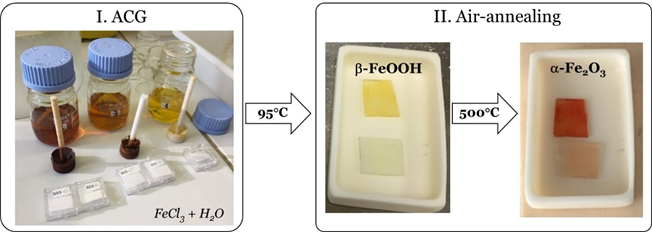Nanomagnetism & Oxides Laboratory
Aqueous chemical growth of nanostructured oxide films
The aqueous chemical growth (ACG) [1] allows growing well-organized nanostructured oxide films with thicknesses from tens to several hundreds of nanometers. For hematite deposition the substrates (e.g. FTO on glass substrates) are dipped in aqueous FeCl3 acidic solution contained in closed bottles. The hydrothermal growth activation is achieved at temperatures lower than 100°C, the substrate being covered by an iron oxy-hydroxide film, the akaganeite phase. Film morphology, thickness, crystallographic and electronic structures, chemical composition are strongly dependent of deposition parameters: solution pH, deposition time, oven temperature, substrate cleaning, etc. Phase transition to hematite (α – Fe2O3) phase is obtained by air annealing at 500 – 600°C.

Iron oxide films elaboration by ACG at SPEC/LNO.
Left: FeCl3 solutions (pH = 1.0, 1.2, 1.4). Right: phase transition by air annealing between the akaganeite (left) and hematite (right)
Left: FeCl3 solutions (pH = 1.0, 1.2, 1.4). Right: phase transition by air annealing between the akaganeite (left) and hematite (right)
[1] L. Vayssieres et al., Chem. Mater. 13, 233 (2001); L. Vayssieres, Int. J. of Nanotechnology 1, Nos. 1/2 (2004)
Mastership:
Victoria Villard, internship M1: Physique et Applications, UPMC: “Synthèse des photo-anodes en solution aqueuse” 2017
Contact: Dana Stanescu from SPEC/LNO
Mastership:
Victoria Villard, internship M1: Physique et Applications, UPMC: “Synthèse des photo-anodes en solution aqueuse” 2017
Contact: Dana Stanescu from SPEC/LNO